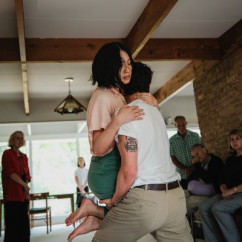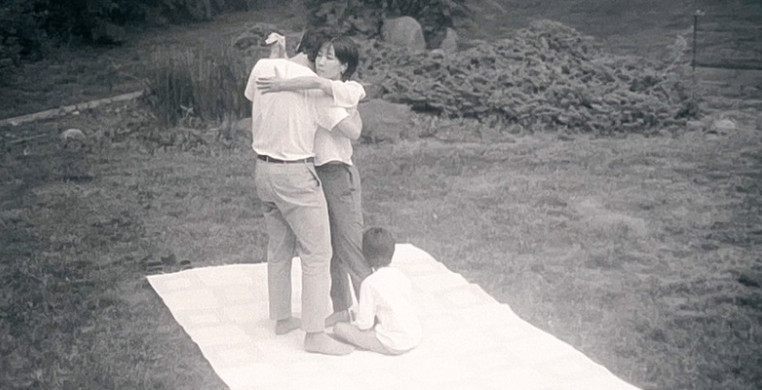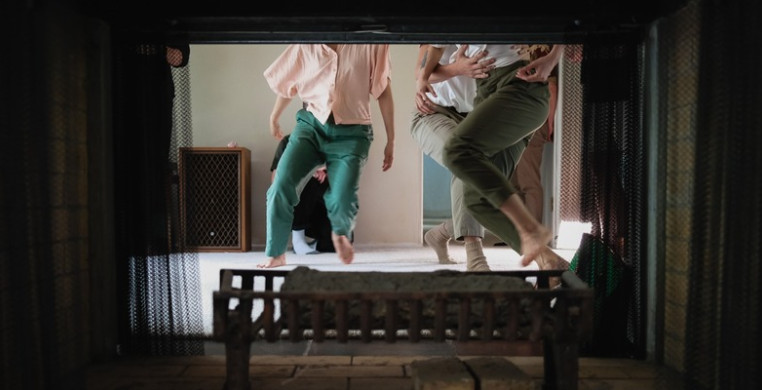Physical spaces, like a childhood home or favorite park, evoke vivid memories and serve as tangible markers of past experiences. These locations, with their unique sensory details, anchor our memories, making the past feel immediate and accessible and allowing us to relive moments from our lives through our once-inhabited spaces.
Robyn Mineko Williams re-enters and reclaims physical space from her past with authenticity and empathy in “Hisako's House.” This promenade-style performance invites its audience to explore a cinematic journey featuring celebrated dance artists Isaac Aoki, Jesse Obremski, Jie-Hung Connie Shiau and Stephanie Terasaki, with a backdrop of music and soundscapes composed by Chicago musician Macie Stewart.
As an immersive, multi-sensory experience of music and movement crafted by award-winning director and artist Williams, audience members are welcomed into her grandparent’s mid-century home where Williams' family lived and gathered for decades. Moving from room to room, you can follow the dance performance at your own pace, creating a personalized viewing experience.
“Hisako’s House." named after Williams’ grandmother, transforms a deeply personal space into a public stage where history and memory intertwine with movement. Dancers weave through areas familiar to their audience—a kitchen counter, a worn armchair, a dining table—each movement resonating and bringing to life the echoes of past generations.
 “Hisako’ House," with Stephanie Terasaki and Isaac Aoki; Photo by Ricardo E. Adame.
“Hisako’ House," with Stephanie Terasaki and Isaac Aoki; Photo by Ricardo E. Adame.
The performance explores the intimate contours of the home, using its physical structures as frames for choreographed solos, duets, and small groups, such as a fireplace creating a window to look through from one room to another, or large window panes in the living room that invite the live world into the indoor space.
By integrating the house's unique architectural landscapes into the choreography, the performance pays homage to Williams’ lineage and invites the audience to reflect on their own connections to home and heritage. The personal and domestic setting creates an immersive experience, highlighting how dance can bridge the personal with the universal, making the private memories of a family home accessible and poignant for all who witness it.
Memory and our perception of experiences shape how we interpret and recall our lives, one of Williams’ recurring themes. Understanding how memory works helps explain how we construct narratives and how past experiences shape our present understanding.
In an interview with See Chicago Dance, Williams explains that her connection to her Japanese culture stems from spending time at her grandparent’s house (Hisako’s House), eating Japanese food and going downtown for special holidays and festivals. It was not until much later in Williams’ life that she sat down with her Grandma and discussed the darker history of her family's experience as Japanese-Americans during and after World War II.
On February 19, 1942, FDR's Executive Order 9066 led to the forced relocation of about 120,000 Japanese Americans, mostly U.S. citizens, to internment camps. Driven by wartime hysteria and racial prejudice, this action violated civil liberties and caused significant trauma and injustice. The internment remains a stark reminder of how civil rights can be undermined in times of crisis.
 “Hisako’ House," Jie Hung Connie Shiau, Jesse Obremski and Knox Murdock; Photo by Jt Williams.
“Hisako’ House," Jie Hung Connie Shiau, Jesse Obremski and Knox Murdock; Photo by Jt Williams.
In “Hisako’s House” Williams is attempting to reclaim her family’s history and culture, through movement, music, and the space which holds a cherished place in her life. She refers to the internment camps and the forced assimilation of Japanese-Americans after WWII as the start of a ripple that led to a lack of knowledge of her own culture growing up. “I think there were times that I felt like I didn’t belong, or I wondered why I didn’t know more about my culture. In doing this project (“Hisako’s House”) I’m learning more about how the government purposefully squashed the history and forced my family to assimilate. There is a reason I don’t know.” Williams finds excitement in learning about her culture still to this day and especially in connecting with other Japanese-Americans, discussing their similar histories and cultural traditions.
Intergenerational trauma describes how the effects of traumatic experiences extend beyond those who lived through them, impacting their descendants as well. This concept underscores that trauma—whether from war, abuse, or systemic discrimination—can ripple through generations, influencing future family dynamics, inherited stress responses and broader societal conditions.
“When I started to discuss my family’s history with them I was learning about what happened after the internment camp and how it affected, in both good and bad ways, the choices that my family and other Japanese-Americans made, in building their lives and how that affected their relationships with their kids and their grandkids. I think that is what is most alive in “Hisako’s House,” the dynamics, ripples and complexities that happened after the internment camp and how that contributed to my experience decades later.”
While William’s family history was the impetus for the creation of this project, Williams’ recognizes and is excited about how audiences will encounter the work and interpret it with their unique perspectives. A key aspect of “Hisako’s House” is the audience's evolving experience as they navigate various spaces in the house. While Williams’ career within the concert dance field did not always put the audience experience at the forefront of the creation process, discussions with her brother and fellow collaborator led her to consider this viewpoint more deeply.
These conversations sparked her interest in site-specific works, highlighting how audience interaction can influence the development of a performance. Williams explains, “I was realizing that I crave to be off of the stage and in closer proximity to the audience. I began to take space and place into account as players in the game and that began to excite me. It happened organically, as I started to follow my instinct and intuition, which led me to a place in my artistic work that feels like home.”
“Hisako’s House” runs Aug 16-25 at The Nishimura Residence in Lombard, IL. The performance lasts about an hour, and guests are welcome to enjoy light snacks and refreshments afterward. On Saturday, Aug 24, RMW&A will present the “Hisako's House: Performance and Family Meal Experience,” which includes the full performance followed by a family-style dinner of Japanese American comfort food shared around the table with the artists of Hisako's House. For tickets, click the event link below or visit https://www.robynminekowilliams.com.


